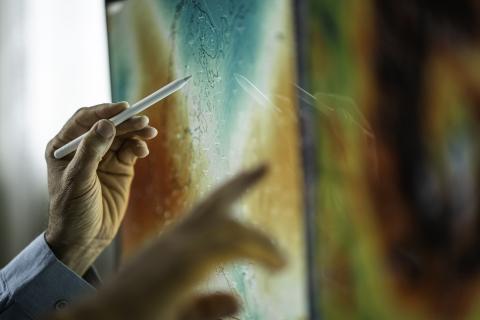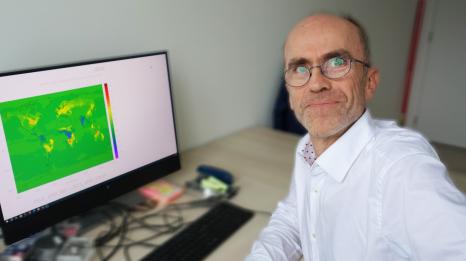
Frédéric Chevallier: atmospheric inversion turned on its head
Frédéric Chevallier is a research scientist at the French Alternative Energies and Atomic Energy Commission (CEA) and leader of the Inverse modelling for atmospheric and satellite measurements (SATINV) team at the Laboratory for Climate and Environmental Sciences (LSCE – Univ. Paris-Saclay/National Centre for Scientific Research, CNRS/CEA/UVSQ). A pioneer in the introduction of artificial intelligence into weather forecasting models, as well as in the mapping of global greenhouse gas emissions and removals, he is now continuing to develop his atmospheric inversion model.
It all began in Rennes, where Frédéric Chevallier grew up reading Sciences et Vie magazine, particularly the articles on aerospace, which he learnt by heart. Later, he was inspired by a 2nd year Master's internship at the Dynamic Meteorology Laboratory (LMD – CNRS/École Polytechnique/ENS - PSL/Sorbonne Univ.), in Palaiseau. The internship then developed into a thesis on the acceleration of a radiative transfer model used in meteorology and climatology. The PhD candidate replaced a complex physical model with a set of artificial neural networks that the LMD's Atmospheric Radiation Analysis team chose to apply to various atmospheric radiation applications in the 1990s. "Today, we talk about automatic learning and artificial intelligence. So, I was working on what we now call machine learning," recalls Frédéric Chevallier, who defended his thesis in 1998. "At the time, atmospheric modellers observed my work cautiously. Today, the use of AI is making headlines, and meteorological centres are recruiting many specialists in this new discipline." His early work took him to the European Centre for Medium-Range Weather Forecasts (ECMWF) in Reading, UK, where he stayed for six years.
From weather forecasting to environmental monitoring
To take weather forecasting beyond a few hours on a national scale, we need to join forces with neighbouring countries, "because the day's weather in mainland France depends on the previous day's weather over the Atlantic Ocean, which also influences the day's weather in Spain or Ireland," points out Frédéric Chevallier. This is how the ECMWF was born. The European centre, whose original mission was to forecast the weather for a few days ahead across the entire globe, delegates shorter-term forecasting to the national centres for their own territories. Since it was created, the ECMWF has expanded considerably, positioning itself, for example, in Earth system modelling and environmental monitoring through the Copernicus programme, and opening a branch in Bologna (Italy) and another in Bonn (Germany). In 2003, Frédéric Chevallier joined LSCE with the aim of helping the CEA to participate in the Copernicus programme. In 2009, he obtained his Accreditation to Supervise Research (HDR).
Atmospheric inversion
Frédéric Chevallier is one of the pioneers of atmospheric inversion for mapping greenhouse gas (GHG) emissions and removals. "GHG concentrations observed in the atmosphere come from an infinite number of emission and absorption scenarios across the globe. To classify them and estimate the most likely scenario, we have to use statistical methods. The inverse approach consists in tracing the outputs of atmospheric transport models, i.e. the GHG concentrations observed in the atmosphere, back to their inputs, i.e. the emissions and removals of these gases." The researcher relies on a theorem mistakenly attributed to the Reverend Thomas Bayes, actually introduced by Pierre-Simon Laplace in 1774. Frédéric Chevallier was also one of the first to tackle large-scale GHG inversion problems, drawing on techniques used in weather forecasting that he learnt at the ECMWF. These techniques enable him to work with the vast data streams generated by satellites to map emissions and removals in unprecedented detail.
Modelling satellite data
Among the highlights of his career, the launches of two American satellites stand out for Frédéric Chevallier. He was present in front of the Vandenberg Space Force Base in California in 2009 for the failed launch of OCO, NASA's first instrument dedicated to measuring CO2, and again in 2014 for the successful launch of the second edition. Sharing both success and failure with the scientific team on this strategic mission is a rare human experience. Today, the researcher is involved in the missions of several French and European satellites. "MicroCarb will be launched by the Centre national d'études spatiales (CNES) in early summer 2025. More compact, lighter and less expensive than OCO-2, it will observe carbon dioxide columns around the globe, with the ambition of doing as well as NASA's instrument. Furthermore, it will analyse an additional spectral band, reducing bias in the final product." In 2027 and 2028, Europe will also launch a constellation of three satellites, intended to capture images of CO2 plumes around the globe.
Increasingly detailed data
In 2022, Frédéric Chevallier discovered how to accelerate his atmospheric transport modelling code. No machine learning this time: He came up with the idea of using graphics cards. "In just two years, graphics processors have revolutionised my work. They've enabled me to considerably enlarge my model, from a resolution of 300 km to 90 km over the entire globe. As for the 22-km resolution, which we're starting to work on, we get several pixels over a distance such as that between Rennes and Saint-Malo, whereas previously a single pixel covered the whole of Brittany! This detail has a direct impact on the capabilities of inversion systems and their various applications, and therefore on potential users." Today, Frédéric Chevallier continues to work on improving the model's resolution, in particular with students from CentraleSupélec. Data from consolidated versions are available free of charge on the ECMWF's Copernicus portal.
The Copernicus programme
"There is a very strong societal interest in atmospheric inversion," says Frédéric Chevallier. This is a source of motivation for his team of around thirty people, and a factor in attracting talent, both from France and abroad. The Copernicus programme also helps to contribute to the team's funding. The ECMWF coordinates the "atmosphere" part of Copernicus and divides the programme into elementary "services", each of which is the subject of calls for tenders for subcontracting agreements lasting two to three years. Frédéric Chevallier has been coordinator of the atmospheric inversion service since the programme started ten years ago and is also responsible for the corresponding CO2 data production chain.
"My job is 90% engineering, developing algorithms and processing data on different computers, and 10% research. As a director of research, I define the research direction that I implement within a team. But this is based on cutting-edge engineering, making possible what was not possible before," concludes Frédéric Chevallier, a researcher who enjoys reconciling these two facets, both of which he finds equally exhilarating.

